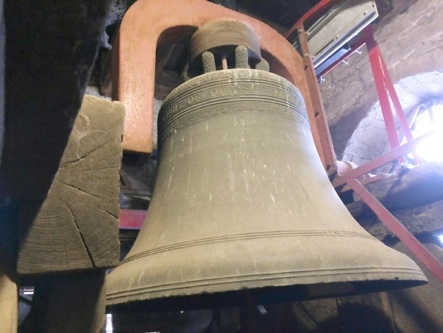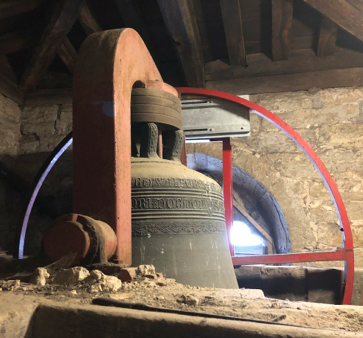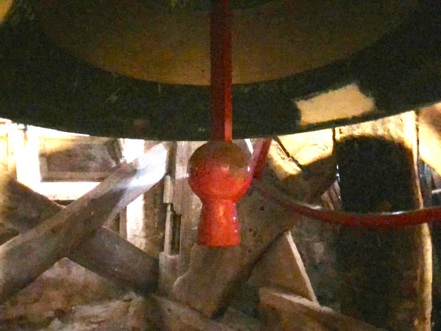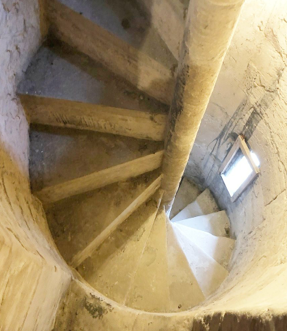
SLHS Curfew Bell



Disclaimer
Whilst some care has been taken to check externally linked websites no responsibility is offered nor implied for the suitability, legality or reliability of content therein.
Statements are made here to the best of our knowledge. However no statement here should be regarded as irrefutable fact. Please contact us if you consider otherwise.
History
In order to reduce crime and to ensure domestic fires were put out at night to avoid towns from being burnt down towns had been ordered to observe The Curfew since William the Conqueror’s time (1066-1087).
In 1442 Sir William Bishopton gave the Guild Chapel its first Curfew Bell. By law it had to be rung at 8pm and all fires were to be extinguished immediately -it must’ve been pretty chilly in mid-winter during the small hours. I wonder how many fires were started by embers escaping from the “bed warmers” of the day ! At first light the bell was rung again to say that fires could be re-ignited and the day’s chores started. As clocks and watches hadn’t been invented by then, and sundials wouldn’t work if the sky was cloudy, the official Curfew Ringer must’ve exercised some judgement.
In 1553 the Guild Of The Holy Cross bequeathed the bell to the Town Council.
In 1591 due to the hammer causing a huge crack the bell (it was perhaps a little over-specified !) it had to be melted down and recast. Indeed in 1615 repairs were required again.
Currently it’s not known what happened to this latter bell. However we do know that this, the third, Great Bell currently in the Guild Chapel tower was originally cast on 10th July 1633 by messers Hugh Watts of Leicester. It weighs 1.41 tons (metric). Around the shoulder of it are written the initials of the members of the corporation for that year: Daniel Baker, Henry Walker, Richard Hathaway and Thomas Quyney.
Ringing The Bell
Of course originally a person was employed by the Town Council to ring the bell manually by means of ropes from the Vestry below. The tradition of reliably sounding the curfew all year round on time had been passed down from generation to generation.
Further Information..
-
Wikipedia: Linear Induction Motor
In the Guild Chapel Tower
● These items have aspects that uniquely contribute to national or world history.
To return to Master page click on ‘Clocks & Bells’ above.
-
● Full
-
● Partial
-
● None
-
Theatres ●


The third giant Curfew Bell of 1663.
SLHS Picture & Document Archives..
-
Large Picture Vault: Guild Chapel Bell Tower & Clock



Reasons For Ringing A Curfew Bell

The more modest clapper - it’s a lonely job !
A New Law
The whole reason for ringing the bell was to remind people to extinguish the fires in their houses overnight. Yet occasionally fires accidentally started during the day and they couldn’t be put out (see Stratford’s Fires -shortcut above). Of course losing your house and contents and possibly loved ones was a serious business and if someone else’s carelessness could be proved in law the defendant, already homeless, most likely had no means to pay compensation to the petitioning litigant.
Thus the Town Council made it law that all building rooves were to be converted to tiled or slate construction. Obviously these are much heavier so new roof beams would be required making the cost considerable but safety made it a necessity. Buildings outside of the town boundary were exempt.
After this point there was no need to ring the bell and it fell silent.
Reasons For Not Ringing The Curfew Bell
It transpires that English people rather liked the ringing of a bell. Indeed East Londoners are only proper Cockneys if they are born within the sound of Bow bells. Stratford’s Great Bell had been rung, not just at Curfew times, but at times of memorial eg when Shakespeare and his various offspring died. It was a tradition that gelled the community in the area and so the ringing of the bell was maintained intermittently throughout the 20th century.
Eventually a petition was put to the Town Council to resurrect the regular ringing of the Curfew Bell as had been for four centuries before. Paying someone to do this would incur significant expense and so John Taylor and Co were asked to install a modern automated system. This is now described.
Reasons For Ringing The Curfew Bell Again
The current system is split into three distinct parts:
-
1. Master Box On the ground floor, in the electrical cupboard in the Vestry, a modem connects to the Internet and monitors the local time (which takes British Daylight Saving time changes into account). If connection is lost it has a real-time clock that keeps reasonably good time. At pre-programmed times, still 8pm at present, a “Go” signal is sent to the next box. This auto mode can be inhibited if there’s a special event occurring locally. Conversely the signal can also be switch on/off manually for special occasions eg HM Queen’s Jubilee.
-
2. Electronic Bell Driver Having climbed the staircase, in a locked cabinet on the first floor, is the electromechanical driver. Upon receiving the “Go” signal from below this will initiate a start sequence where the bell is rocked backwards and forwards in an ever increasing arc until the pre-defined swinging angle is reached and the bell clapper causes it to ring. This continues whilst the “Go” signal is present and then braking occurs when the “Go” signal is no longer received.
-
3. Linear Induction Motor For safety, reliability, quietness of operation, electrical efficiency and as it needs absolutely no maintenance the bell is not rocked by gears, pulleys, weights, ropes or springs but by an Eric Laithwaite style linear induction motor (see below). This cunning simple set of groups of three coils is within the aluminium plate on the far side of the original rope wheel in image 3 below. By this means the acceleration, braking and monitoring of the movement of the huge weight is all under electronic control.
Modern Curfew Bell Ringing System In Three Parts

①
②
③
Last update: 31/10/2024
Created: 14/04/2024
Vestry Power Cupboard: Master Controls
Mediaeval staircase to upper floors
with window over Church Street
First Floor: Electro-mechanical controls
The Great Bell and its Linear Motor
(Purely mechanical, smaller, hourly chime bell to left but not shown)
French Origin
The English word is derived from the abbreviated concatenation of two French words:
-
cuvrir
-
feu
The French also had to cover their fires and used the word cuevrefeu which was Anglicised to ‘curfew’.
Origin Of The Name: Curfew
- the verb to cover
- the word for fire
